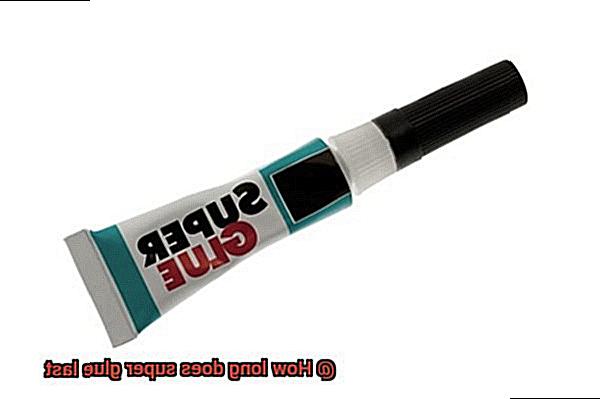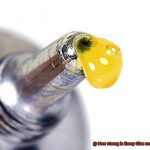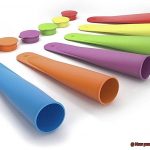Get ready to dive headfirst into the captivating world of super glue – that sticky wonder that saves the day in our everyday lives. Whether you’re a crafty creator, a household fixer-upper, or a DIY enthusiast, super glue is your trusty sidekick with its unbeatable bonding powers. But have you ever wondered just how long this magical adhesive can hold things together?
In this blog post, we’re going to unravel the mystery of super glue’s longevity. We’ll give you all the essential info to ensure your projects stand strong for ages to come.
Originally created as a versatile adhesive for industrial use, super glue, also known as cyanoacrylate adhesive, has found its way into our homes and workshops. While different brands may have their own secret formulas, they all share one key ingredient – cyanoacrylate.
One thing that sets super glue apart is its lightning-fast drying speed. It forms an incredibly strong bond within seconds, making it a favorite among hobbyists and professionals alike.
But here’s the burning question: how long does that bond actually last? Well, it depends on a few factors like the materials being bonded, how you apply it, and even the environment it’s in. Generally speaking though, when used correctly, super glue creates a bond that can withstand some serious stress.
We’ll take a deep dive into the nitty-gritty details of super glue longevity – exploring how temperature and humidity affect its performance and what types of materials it works best with. Plus, we’ll dish out some handy tips and tricks to make sure your projects stay rock-solid over time.
So come along on this adventure as we uncover the secrets behind super glue’s durability. Arm yourself with knowledge so you can choose the right adhesive for any job and guarantee your projects go from ordinary to extraordinary – all thanks to the power of a tiny tube of glue.
What is Super Glue?
Contents
- 1 What is Super Glue?
- 2 Factors Affecting the Longevity of Super Glue
- 3 Proper Use and Storage of Super Glue
- 4 Curing Time of Super Glue
- 5 Strength and Durability of a Super Glue Bond
- 6 Repairing Failed or Weakened Bonds
- 7 Extending the Lifespan of Super Glue Bonds
- 8 Different Types of Super Glues
- 9 Conclusion
Super Glue, officially known as cyanoacrylate adhesive, is a remarkable adhesive that has revolutionized the way we bond materials together. With its lightning-fast action and ability to create strong bonds in mere seconds, it has become the go-to adhesive for DIY enthusiasts, craftsmen, and professionals worldwide. In this article, we will delve into the history, composition, application methods, advantages, and disadvantages of this extraordinary adhesive.
A Brief History:
The journey of Super Glue began in the 1940s when Dr. Harry Coover accidentally discovered its adhesive properties while searching for a clear plastic for gun sights during World War II. This serendipitous discovery led to the development of cyanoacrylate adhesives, which would later be commercialized as Super Glue.
Composition and Working Mechanism:
Super Glue’s main ingredient is cyanoacrylate, an acrylic resin that undergoes a fascinating process called polymerization upon contact with moisture. This reaction creates robust molecular chains, instantly bonding surfaces together. It’s important to note that moisture is crucial for the adhesive to work effectively.
Application Methods:
Super Glue comes in small tubes or bottles with narrow applicator tips for precise application. Before applying the adhesive, ensure that the surfaces are clean and free from oil, dirt, or moisture. Apply a thin layer of glue onto one surface and firmly press the two surfaces together. The bond will form within seconds.
Advantages:
- Versatility: Super Glue can bond a wide range of materials, including plastic, metal, rubber, ceramics, and wood.
- Strength: It boasts exceptional tensile strength, making it ideal for applications where a strong and permanent bond is required.
- Resistance: Super Glue can withstand extreme temperatures (-40°F to 180°F), making it suitable for both indoor and outdoor use.
Quick curing: It forms bonds within seconds, saving time and increasing productivity.
Disadvantages:
- Lack of flexibility: Super Glue bonds may become brittle when subjected to frequent bending or twisting.
- Difficult to remove: Once cured, it is challenging to remove or re-bond surfaces with the same strength.
- Short shelf life after opening: Once the adhesive bottle is opened, its lifespan significantly decreases.
Factors Affecting the Longevity of Super Glue
Let’s dive into the world of super glue and explore the key factors that contribute to its longevity.
First and foremost, the quality of the super glue itself plays a significant role in its longevity. High-quality super glue tends to last longer compared to low-quality ones. So, when it comes to choosing your glue, be sure to opt for a reputable brand and ensure that the glue is fresh and has not expired.
Next, surface preparation is crucial for the longevity of super glue bonds. For optimal adhesion, it is important to clean and dry the surfaces thoroughly before applying the glue. Any dirt, grease, or moisture can hinder the bonding process and reduce the longevity of the glue.
The type of materials being bonded also affects the longevity of super glue. While some materials like plastics and metals bond well with super glue and contribute to its longevity, others like glass or certain types of fabrics may not bond as effectively, resulting in shorter durability. So, it’s important to consider the compatibility of materials before using super glue.

Environmental factors such as temperature and humidity can also impact the longevity of super glue. Extreme temperatures, both hot and cold, can affect the bonding strength and durability of the glue. Similarly, high humidity levels can slow down the curing process of super glue and reduce its overall effectiveness.
The amount of glue applied is another factor to consider. Applying too little glue may result in weak bonding, while applying excessive amounts can lead to excessive shrinkage or overflow, compromising the durability of the bond. So, it’s essential to find the right balance when applying super glue.
Lastly, how you handle and stress the bonded area can affect the longevity of super glue. Once the glue has been applied, it’s important to avoid excessive stress or movement on the bonded area during the initial curing period. Prematurely subjecting the bond to stress can weaken its strength and reduce its overall lifespan.
Proper Use and Storage of Super Glue
Today, we’re going to dive deeper into the world of super glue and uncover the secrets to its longevity. So grab your glue guns and let’s get started.
First things first, before you even think about applying that super glue, make sure you clean and dry the surfaces that need to be bonded. Dirt, dust, or moisture can interfere with the bonding process and weaken the bond. Think of it like trying to stick two pieces of paper together with a layer of jelly in between – not a great idea, right?
Speaking of not-so-great ideas, using super glue in a poorly ventilated area is a big no-no. The fumes released during the curing process can be irritating to your eyes, nose, and throat. So open up those windows or turn on a fan to keep the air flowing and avoid any unpleasant side effects.
Now, let’s talk about application. When it comes to super glue, less is definitely more. Trust me on this one – a little goes a long way. Using too much can lead to messy application and excess glue oozing out of the bond. And nobody wants that sticky situation on their hands (literally.).
Instead of going for a thick layer of glue, opt for thin layers. Thin layers allow for better contact between the surfaces and ensure a stronger bond. It’s like building a solid foundation for your glue masterpiece – start small and build up from there.
Once you’ve applied the super glue, hold those surfaces firmly together for a few seconds. Applying pressure helps in achieving a stronger and more durable bond. It’s like giving your glue creation a warm hug – it just feels right.
Now let’s move on to storage. Properly storing your super glue is essential for maintaining its effectiveness and prolonging its shelf life.
- Store it in a cool, dry place: Keep your super glue away from direct sunlight and heat sources. Exposure to heat or sunlight can cause the glue to degrade and lose its bonding properties. And nobody wants a glue that’s lost its magic touch.
- Tightly seal the container: Always make sure to tightly seal the container after use to prevent moisture from getting in. Moisture can cause the adhesive to harden inside the container, rendering it unusable. And we definitely don’t want that.
- Keep it out of reach: Super glue should be kept out of reach of children and pets. It can be harmful if ingested or if it comes into contact with the skin or eyes. Safety first, folks.
- Clean up any leakage: In case you experience any leakage, clean it up promptly. We don’t want any accidents or damage to surfaces, do we? So grab a paper towel and wipe away those gluey messes.

In case you accidentally get super glue on your skin, wash it off immediately with soap and water. If you need some extra help, acetone or nail polish remover can be used to dissolve the adhesive. Just be careful not to turn your fingers into a science experiment.
Curing Time of Super Glue
The curing time of super glue is a fascinating topic that involves multiple factors. When it comes to this powerful adhesive, there is no one-size-fits-all solution. Let’s explore the world of glue and uncover the secrets behind its drying process.
Curing time refers to the duration it takes for super glue to fully dry and bond surfaces together. However, this time can vary depending on various factors. Consider the following:
- The type and brand of glue: Different super glues have different properties, resulting in varying curing times. Some formulas are designed for specific materials or bonding requirements, while others boast faster curing times.
- The materials being bonded: The nature of the materials being joined also affects the drying process. For instance, bonding metal surfaces tends to take longer than bonding plastic pieces. This discrepancy arises because metal is less porous and requires additional time for the adhesive to penetrate and create a strong bond.
- Environmental conditions: Temperature and humidity play significant roles in the curing time of super glue. In colder temperatures, the adhesive may require more time to cure, whereas warmer temperatures can expedite the process. Thus, when working in either extreme, be prepared for variations in drying time.
- Now, here’s a pro tip: patience is key when it comes to curing super glue. Though it may appear dry on the surface within seconds, it is best to let it sit undisturbed for at least 24 hours to reach its maximum strength. During this time, a chemical reaction occurs between the adhesive and moisture in the air, ensuring a durable bond.
In summary, the curing time of super glue varies depending on the type and brand of glue, the materials being bonded, and environmental conditions such as temperature and humidity. By considering these factors and exercising patience, you can achieve optimal results when using this powerful adhesive.
Strength and Durability of a Super Glue Bond
Welcome to the world of super glue, where bonds are created in an instant, and strength is a top priority. Have you ever wondered what factors determine the strength and durability of a super glue bond? If so, you’ve come to the right place. In this blog post, we will explore the fascinating world of super glue adhesives and uncover the secrets behind their incredible bonding capabilities.
Factors Affecting Strength:
Material Compatibility:
Super glue works best on non-porous materials such as metal, glass, and plastic. These surfaces allow the adhesive to penetrate and bond effectively, resulting in a strong and durable connection. Conversely, bonding porous materials like wood or fabric may yield a weaker bond due to limited penetration into the pores or fibers.
Surface Preparation:
Proper surface preparation is crucial for achieving a strong bond. Ensure that the surfaces being bonded are clean, dry, and free from contaminants like grease or dirt. This step maximizes contact between the adhesive and material, enhancing bond strength.
Factors Affecting Durability:
Environmental Conditions:
While super glue bonds are generally durable, extreme temperatures can impact their longevity. Excessive heat can soften or weaken the adhesive, while extreme cold can make it brittle and prone to breaking. Additionally, prolonged exposure to moisture can weaken the bond over time.
Application-Specific Stresses:
Consider the specific application and potential stressors that may impact the bond’s durability. A bond holding lightweight materials may last longer than one under heavy load or constant movement. Understanding the demands of the application helps determine how long-lasting the bond will be.
In conclusion, super glue is an incredible adhesive known for its quick bonding abilities. The strength and durability of a super glue bond depend on various factors like material compatibility, surface preparation, environmental conditions, and application-specific stresses. By understanding and considering these factors, you can maximize the strength and longevity of your super glue bonds.
Repairing Failed or Weakened Bonds
Today, we’ll dive into the art of repairing failed or weakened bonds using this miraculous adhesive. Whether you’re a DIY junkie or just an everyday fixer-upper, these tips and tricks will have you wielding your super glue like a pro.
Step 1: Assess the Damage
Before embarking on your bonding adventure, take a moment to evaluate the extent of the bond failure or weakening. Bid farewell to any remnants of the old adhesive and gently scrape away residue using a blunt tool or sandpaper. Remember, cleanliness is key.
Step 2: Choose the Right Glue
Just like picking the perfect partner, choosing the right super glue is essential for a strong bond. Metal, plastic, wood, ceramics – they all have their own special glue match. Select a super glue specifically designed for the material you’re repairing.
Step 3: Roughen Up the Surface
Give that surface a little TLC. Lightly roughen it with sandpaper to create more surface area for our adhesive superhero. A cleaner surface equals a stronger repair. Wipe away grease or dirt with a mild solvent or rubbing alcohol before gluing.
Step 4: Apply with Care
Now it’s time for the main event – applying the super glue. But remember, less is more in this case. Apply a tiny amount for a strong bond. Avoid turning your repair project into a sticky mess. Apply in thin layers for even distribution and better control.
Step 5: Press Firmly (But Not Too Hard)
A gentle touch can make all the difference. Press surfaces together firmly for a few seconds, allowing the adhesive to spread evenly. But be cautious, my friend. Avoid excessive force, especially on delicate materials. Don’t break more than you fix.
Step 6: Patience is a Virtue
Now comes the hardest part – waiting. Give your repair project the time it needs to cure undisturbed. Consult the super glue’s packaging for the recommended curing time. Trust me, impatience can lead to a weak bond, and we don’t want that after all your hard work.
Step 7: Waterproof Your Bonds
If moisture is the culprit behind your bond failure, fear not. There are specialized water-resistant or waterproof super glues available. These magical glues withstand the wettest of conditions. Just remember, they may require longer curing times or specific application techniques.
Extending the Lifespan of Super Glue Bonds
Super glue, the adhesive superhero, has the power to create strong and durable bonds. But how can we extend their lifespan? In this article, we will explore the art of maximizing the longevity of super glue bonds. By following these expert tips, you’ll become a master in the world of adhesive strength.
Cleanliness is Key:
Before applying super glue, cleanliness is crucial. Ensure that the surfaces being bonded are free from dirt, dust, and oils. Swipe them with a mild detergent or alcohol-based cleaner to eliminate any contaminants that could compromise the bond’s strength.
Dry it Out:
Moisture is the nemesis of super glue bonds. Make sure the surfaces are completely dry before applying the adhesive. Let them air dry or use a clean cloth to remove any remaining moisture. This step ensures strong bonds and a longer lifespan.
The Right Amount Matters:
Finding the perfect balance between too little and too much glue is key. Applying too little may result in a weak bond, while excess glue can create a messy situation and hinder proper curing. Follow the manufacturer’s instructions for optimum results.
Temperature Check:
Super glue performs best at room temperature. Avoid applying it in extreme heat or cold environments, as this can affect the bond’s strength and longevity. Stick to ideal temperature ranges for maximum effectiveness.
Patience is a Virtue:
Once you’ve applied the glue, resist the temptation to disturb the bonded objects during the curing process. Prematurely applying pressure or moving them can weaken the bond and reduce its lifespan. Hold them together firmly for a few minutes or as per the manufacturer’s instructions for proper curing.
Time for Full Strength:
Some super glues require additional curing time to reach maximum strength. Check the instructions provided by the specific brand you’re using and allow sufficient time for complete curing. Remember, patience pays off with a bond that can stand the test of time.
Avoid Extremes:
To extend the lifespan of your super glue bonds, protect them from extreme temperatures, moisture, and harsh chemicals. Shield your bonds from these elements to ensure their longevity and durability.
Maintenance Matters:
Regular maintenance and care of bonded objects are crucial for extending the lifespan of super glue bonds. Avoid excessive stress or strain on the bonded area, and keep it clean and dry. By doing so, you’ll ensure the longevity of your bond.
Repair with Care:
In the unfortunate event that a super glue bond weakens or breaks, it is possible to repair it by applying additional glue to reinforce it. However, be cautious as multiple applications may compromise the bond’s strength. Address any issues promptly to maintain its integrity.
Different Types of Super Glues
In this guide, we will delve into the different types of super glues available in the market and discover their unique properties and characteristics. So, let’s put on our safety goggles and embark on this adhesive adventure.
Cyanoacrylate Super Glue:
The first type we encounter is cyanoacrylate super glue, renowned for its lightning-fast bonding power. This versatile glue can adhere to a wide range of materials, including metal, plastic, wood, and ceramics. However, be cautious while using it, as this powerful adhesive can also bond skin together.
Epoxy Super Glue:
Next up is epoxy super glue, the superhero of adhesives. Composed of two separate components that are mixed before use, epoxy glue provides an incredibly strong and durable bond. Its slow-setting nature allows for precise positioning of materials, making it perfect for heavy-duty projects requiring long-lasting hold.
Gel Super Glue:
Moving along, we encounter gel super glue. With its thick and gooey consistency, gel glue is ideal for tricky jobs where precision is key. No more messy drips. Gel super glue stays put and works wonders when sticking things together on vertical surfaces or when you need impeccable control over the application.
Specialty Super Glues:
Did you know that there are specialized super glues tailored to specific materials? For instance, there are glues designed exclusively for rubber or leather bonding. Isn’t that amazing? Moreover, if you’re working with high-temperature materials, fear not. Heat-resistant super glues are available that maintain their grip even under extreme heat conditions.
Choosing the Right Glue:
When selecting a super glue, it’s crucial to consider the materials you’re bonding and the required strength. Take the time to read labels and instructions carefully, ensuring you select the appropriate glue for your project. Keep in mind that different brands may offer variations in their formulas, so checking reviews or seeking recommendations can be beneficial.
Also Read: Does Glue Expire?
Conclusion
Super glue, a powerful adhesive that can bond materials together with incredible strength, is known for its long-lasting properties. But just how long does super glue really last? Well, the answer depends on various factors such as the quality of the glue and the conditions it is exposed to.
In general, super glue has a shelf life of about one to two years when stored properly in a cool and dry place. However, once opened, its lifespan can be significantly shorter. Once exposed to air, super glue can start to harden and become less effective over time.
The longevity of super glue also depends on the surfaces it is applied to. Smooth and clean surfaces tend to provide better adhesion compared to rough or dirty surfaces. Additionally, certain materials like plastic or metal may require special formulations of super glue for optimal bonding.
Furthermore, environmental factors play a crucial role in determining how long super glue lasts. Extreme temperatures or excessive moisture can weaken the adhesive properties of the glue, causing it to deteriorate more quickly.
So, while super glue is renowned for its durability and strength, it’s important to consider these variables when estimating its lifespan. To ensure maximum effectiveness, it’s recommended to use fresh tubes of super glue for important projects and store them properly when not in use.
In conclusion, while there isn’t a definitive answer to how long super glue lasts, taking into account factors such as storage conditions, surface preparation, and environmental influences can help maximize its lifespan.






